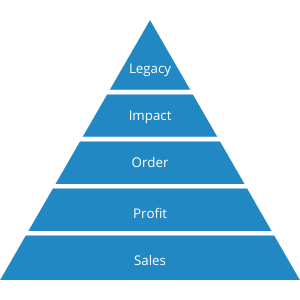When you are a business owner, you live in a world that is continually changing.
One day, you’re focusing on marketing campaigns.
The next day you’re focusing on making payroll.
The next day you’re closing an exciting new deal.
Or you might be doing all of these in just one day.
One of the biggest challenges business owners face is that their priorities seem to change daily if not hourly.
Too often, we get caught up in putting out fires that left unattended will consume the business.
This can lead to us feeling like we’re always chasing our tails and running around in circles.
In what seems like a never-ending cycle of dealing with urgency we never seem to have time to work on the most important items in our business.
We get caught in the weeds, and sometimes we get lulled into thinking if I could just get my head above the weeds, then I would be able to make significant improvements in business.
The challenge, in many instances, is we are so bombarded with problems in business that we don’t know which problem should be solved first.
Many business owners focus first on increasing sales believing the myth that increased sales solves all problems.
While increased sales could be the answer, sometimes it increased sales will drive a business under.
There are countless stories of businesses that had products featured as one of Oprah’s favorite things.
Those businesses were unable to handle the demand that Oprah’s magic touch brought to their business, and soon the increased sales shut down the business.
In his forthcoming book Fix This Next!, Mike Michalowicz introduces us to the idea of the Entrepreneurial Hierarchy of Needs.
The Entrepreneurial Hierarchy of Needs is modeled after Maslow’s Hierarchy of Needs.
The Entrepreneurial Hierarchy of Needs gives us a new way to view our businesses.
The Entrepreneurial Hierarchy of Needs gives us a framework to solve the most important need first.
There are five layers of the Entrepreneurial Hierarchy of Needs are:
- Sales
- Profit
- Order
- Impact
- Legacy
To understand how the Entrepreneurial Hierarchy of Needs works, let’s go back to Maslow’s hierarchy of needs and see how that would work.
The first level of Maslow’s Hierarchy is Physiological Needs such as air, food, water, and shelter.
If we are not getting enough air to breathe, it doesn’t matter if we live in a fancy house on the Riviera.
First, we have to find a solution to the breathing problem before we can grow as a person.
The same thing applies to business.
The first need a business has is to create sales.
If the business doesn’t create sales, the business will cease to exist.
However, once the business has sound sales systems in place, the sales need becomes fulfilled and it becomes important to focus on other business needs.
As the business grows and matures, it will ascend and descend the Entrepreneurial Hierarchy of Needs.
Without knowing which need is most pressing, we too often revert to fulfilling a need that worked in the past.
For instance, we may have focused on increasing sales.
If the primary need of the business is profit improvement, then increasing sales will not solve the profit problem.
This may seem counterintuitive to many people.
If my business brings in more money, won’t I be more profitable?
Maybe, if the business is operated by a solo operator.
However, there will come a time when that solo operator runs out of time.
When that time comes, the solo operator will have to hire people or vendors to fulfill the work generated by new sales.
If the business is not operating profitably at $500,000 in sales, the chances of the business operating profitably at $1,000,000 in sales are unlikely because it becomes more expensive to operate the business as it generates more revenue.
With the Entrepreneurial Hierarchy of Needs, we now have a tool that will help us determine what our business needs most and then work on fulfilling that need.
Before I end this article, I wanted to ask you if you’re looking to grow your business profits and having more cash in the bank, send me an email at damon@idealmoneylife.com with “PROFIT” in the subject line… tell me a little about your business and what you’d like to work on together, and I’ll get you all the details!

Recent Comments